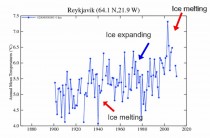By Steve Goddard
Hansen’s original data accurately showed the rapid warming during the 1920s, the 1940s temperature spike, and the rapid cooling during the 1970s.
Melting in 1940 :
The Courier-Mail Monday 6 May 1940
By far the largest number of local glaciers in north-east Greenland had receded very greatly during recent decades, and it would not be exaggerating to say that these glaciers were nearing a catastrophe.
In Alaska glaciers had been retreating from 100 to 200 years, the average rate of recession being about 50 feet a year. The Antarctic ice- sheet also showed signs of recent retreat.
“In fact,” said Professor Speight, “no case is recorded of a region of the world in which there are present signs of an advance.
The Sydney Morning Herald Friday 13 January 1939
The CIA wrote of ice expansion in 1974 :
“Early in the 1970s … the world’s snow and ice cover had increased by at least 10 to 15 percent”
Science News wrote this in 1975
The weather in the first part of this century has been the warmest and best for world agriculture in over a millenium, and, partly as a result, the world’s population has more than doubled. Since 1940, however, the temperature of the Northern Hemisphere has been steadily falling: Having risen about 1.1 degrees C. between 1885 and 1940, according to one estimation, the temperature has already fallen back some 0.6 degrees, and shows no signs of reversal. Specific areas, of course, may experience changes markedly different from the average. During the warming period, temperatures in parts of Norway rose five times more than the hemisphere average, and since the cooling trend began again, Iceland’s temperature has dropped nearly 2.0 degrees, threatening continued existence of some crops.
By contrast, Hansen’s new corrected data makes no sense. He now shows early 1970s temperatures warmer than 1930s temperatures.

Unless the freezing point of water has changed, Hansen’s “corrections” are bogus. They appear to be based on politics, not science.
See post. See more on GISS nonsense here.





